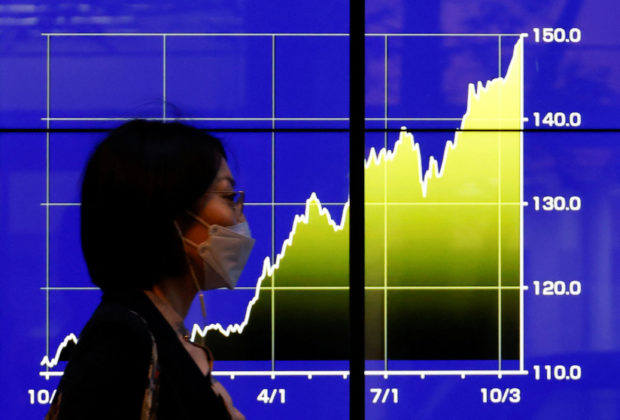
A passerby walks past an electric monitor displaying the graph of recent movements on Japanese yen exchange rate against the U.S. dollar in Tokyo, Japan, Oct 20, 2022. REUTERS/Issei Kato
TOKYO -Japan’s currency interventions have been stealth operations in order to maximize the effects of its forays into the market, Finance Minister Shunichi Suzuki said on Tuesday, after the government spent a record $43 billion supporting the yen last month.
Bank of Japan Governor Haruhiko Kuroda, however, reiterated the central bank’s resolve to keep interest rates ultra-low, indicating that the yen’s broad downtrend could continue.
Japanese officials remain tight-lipped on exactly when they intervened in the market in October. Full details of their actions will not be available until quarterly intervention data is published. The July-September data is expected to be released early this month.
“There are times when we announce intervention right after we do it and there are times when we don’t,” Suzuki told a news conference on Tuesday. “We are doing this to maximise effects to smoothe sharp currency fluctuations.”
The finance minister repeated his warning that authorities were closely watching market moves and would not tolerate “excessive currency moves driven by speculative trading”.
Japan spent 6.35 trillion yen ($42.7 billion) on currency intervention in October to prop up the yen, data showed on Monday, leaving investors keen for clues about how much further the authorities might step in to soften the yen’s sharp fall.
A steep drop in the yen to a 32-year low of 151.94 to the dollar on Oct. 21 likely triggered the intervention, which was followed by another round on Oct. 24. In September, when Japan conducted its first yen-buying intervention since 1998, authorities immediately confirmed they had stepped in.
Since the Oct. 21 intervention, the yen has been moving in a range below the psychologically important threshold of 150 yen versus the dollar. On Tuesday, the Japanese currency was changing hands at 148.70 per dollar, little changed from the previous session.
While the possibility of another round of currency intervention is keeping yen bears at bay for now, investors are bracing for more volatility ahead of a closely watched U.S. Federal Reserve policy meeting that ends on Wednesday.
The Fed is widely expected to raise rates by 75 basis points for a fourth straight time, while debating when to downshift to smaller rate hikes to avoid sending the economy into a tailspin.
In a sign that the onus of addressing sharp yen declines will remain with the government rather than with the central bank, the BOJ’s Kuroda ruled out the chance of raising Japan’s ultra-low rates anytime soon.
“Japan’s economy is still in the midst of recovering from the coronavirus pandemic’s impact. As such, it’s necessary to support the economy with acccomodative monetary policy,” Kuroda told parliament on Tuesday.
Kuroda brushed aside criticism, raised by some politicians, that the BOJ’s resolve to maintain an ultra-loose policy was inconsistent with the government’s efforts to curb the yen’s fall.
“Our policy and that of the government complement each other,” Kuroda said. “There’s no doubt the BOJ needs to cooperate closely with the government.”
($1 = 148.6100 yen)